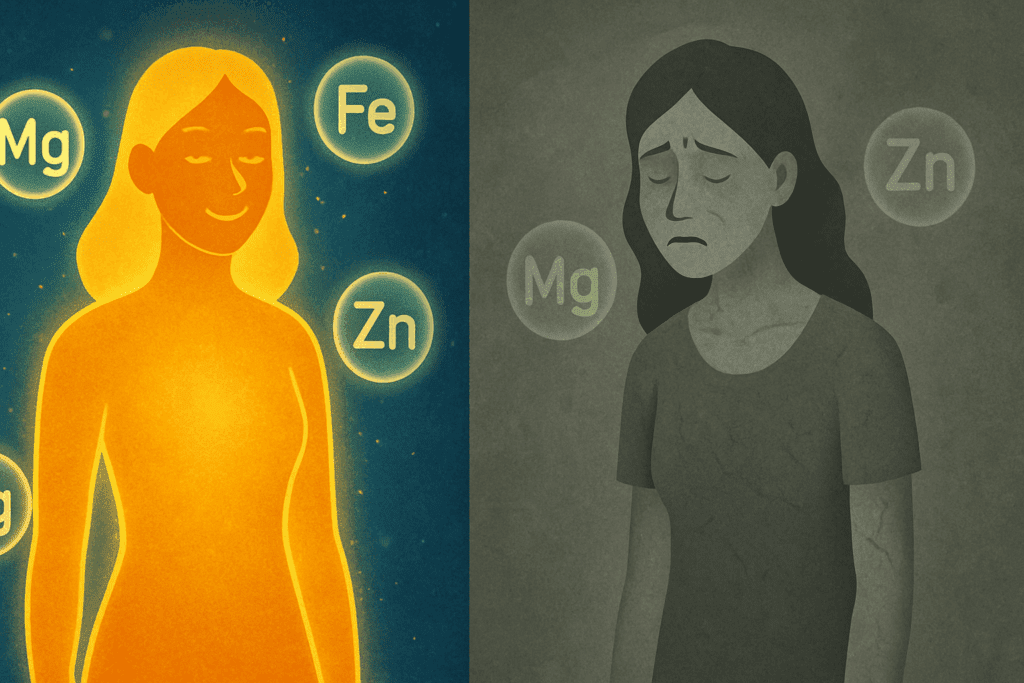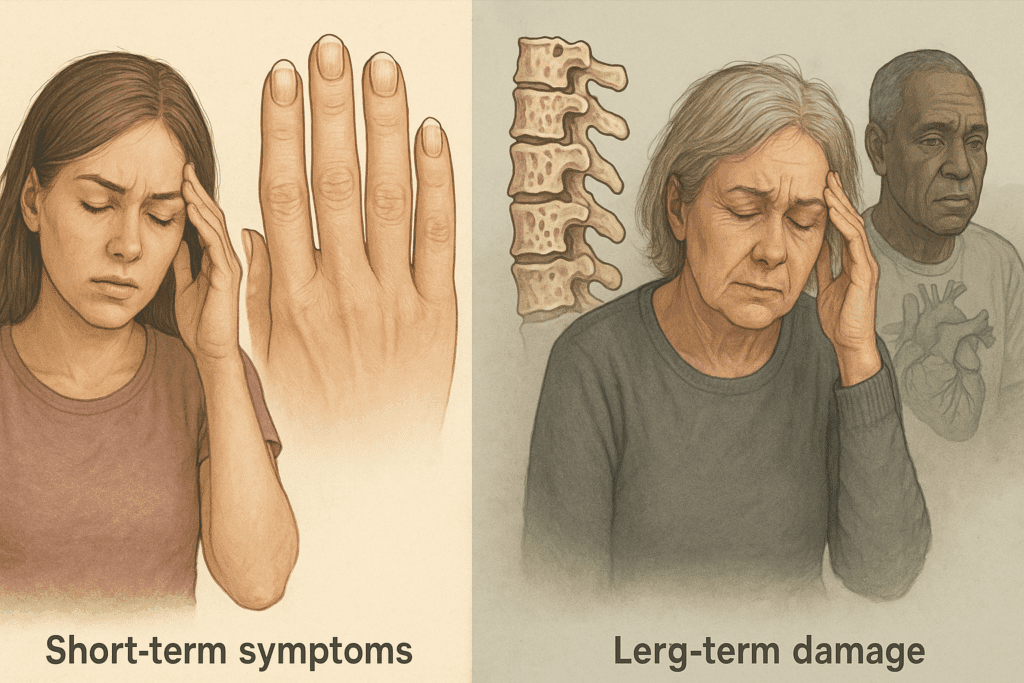Introduction: Why You Should Pay Attention to Nutrient Deficiency Symptoms
In a world where processed foods dominate grocery store shelves and fast-paced lifestyles often overshadow mindful eating, it has become increasingly common for individuals to unknowingly experience symptoms related to nutrient deficiencies. These subtle signals from your body can often be mistaken for stress, fatigue, or aging—but they may be telling you something far more significant. Nutrient deficiencies do not just impact your energy levels; they can affect nearly every physiological system in your body, from immune function to cognitive clarity, and even your ability to maintain optimal growth during developmental stages.
You may also like: Macronutrients vs Micronutrients: What the Simple Definition of Macronutrients Reveals About Your Diet and Health
Recognizing a list of common nutrient deficiency symptoms can make a profound difference in your overall wellness. Whether you are navigating unexplained fatigue, brittle nails, or persistent nausea, it may be time to evaluate whether your body is receiving the vitamins and minerals it needs to function at its best. This article explores the signs you shouldn’t ignore, breaks down the science behind specific nutrient and mineral deficiency diseases, and offers practical strategies to help restore balance through diet and supplementation.

What Is a Nutrient Deficiency? Simple Definitions and Key Concepts
A nutrient deficiency, simply defined, occurs when the body does not get enough essential vitamins or minerals to meet its needs. These deficits can result from poor dietary intake, malabsorption, chronic diseases, or increased nutrient demands due to age, pregnancy, or medical treatments. When your body lacks a key nutrient, it cannot perform vital cellular functions efficiently, leading to a wide range of symptoms.
One of the most important things to understand about nutrient deficiency is that it doesn’t always manifest immediately. The body is remarkably adaptive, often prioritizing vital functions while depleting internal reserves. By the time symptoms arise, the deficiency may already be advanced. Therefore, knowing the 3 symptoms of a mineral deficiency and other early warning signs can help prevent long-term health complications.
Additionally, nutrient deficiencies are not just isolated issues. They can be interconnected. For example, low magnesium levels can impair vitamin D metabolism, while a deficiency in vitamin B12 can mimic the signs of folate deficiency. Understanding this complexity is essential for anyone trying to restore their health holistically and sustainably.

A Closer Look at Vitamin Deficiency Symptoms
Vitamin deficiencies can have a wide array of physical, neurological, and psychological effects. The severity of these symptoms often depends on how long the deficiency has gone unrecognized. A comprehensive vitamin deficiency symptoms chart can help guide clinical diagnosis, but here we’ll break down some of the most prevalent types.
Vitamin D: Fatigue, Bone Pain, and Depression
Vitamin D deficiency is remarkably common, especially in regions with limited sun exposure. This essential fat-soluble vitamin helps regulate calcium absorption and supports immune health. When deficient, individuals may experience bone pain, muscle weakness, and frequent infections. Mood disorders like depression and seasonal affective disorder (SAD) are also frequently linked to low vitamin D levels.
If you often feel sluggish despite adequate sleep, or experience musculoskeletal discomfort, you might be facing a nutrient deficiency involving vitamin D. Long-term consequences can include osteoporosis and an increased risk of autoimmune diseases, making early detection critical.
Vitamin B12: Neurological Changes and Anemia
Vitamin B12 deficiency can develop insidiously, often masked as general fatigue or forgetfulness. However, the consequences are serious—without sufficient B12, your body cannot produce healthy red blood cells or maintain nerve function. Symptoms include memory issues, tingling or numbness in extremities, and even mood disturbances like irritability or depression.
For those on vegetarian or vegan diets, understanding what vitamin deficiencies make us shorter or more neurologically vulnerable is crucial. Since B12 is mostly found in animal products, these individuals are at heightened risk and should consider fortified foods or supplements.
Vitamin A: Vision and Immunity Problems
Night blindness is one of the earliest signs of vitamin A deficiency. This essential nutrient supports healthy vision, epithelial tissue integrity, and immune resilience. Inadequate intake can also lead to dry skin, respiratory issues, and increased susceptibility to infections. Since vitamin A plays a role in gene expression and cell differentiation, its absence can severely impair healing and development.
Foods like liver, sweet potatoes, and leafy greens can prevent this deficiency, but in developing regions, vitamin A deficiency remains a major public health issue, especially among children.
Vitamin C: Bruising, Swollen Gums, and Slow Healing
Perhaps the most well-known vitamin due to its association with scurvy, vitamin C is a water-soluble antioxidant essential for collagen synthesis and immune function. Deficiency may manifest as easy bruising, swollen or bleeding gums, and wounds that take an unusually long time to heal. Some people also experience nausea and micronutrient deficiency symptoms like fatigue and joint pain simultaneously.
Since the body doesn’t store vitamin C, consistent intake through citrus fruits, peppers, and cruciferous vegetables is key.

Uncovering the Hidden Dangers of Mineral Deficiencies
Minerals play foundational roles in bone development, enzyme function, nerve transmission, and fluid balance. A disruption in these delicate systems can be catastrophic. Here, we explore several of the most critical mineral deficiencies and the diseases they may cause.
Iron: The Most Common Mineral Deficiency Worldwide
Iron deficiency is a leading cause of anemia globally, affecting children, women of reproductive age, and individuals with chronic illnesses. Early signs include fatigue, paleness, cold extremities, and brain fog. Without enough iron, your body cannot produce sufficient hemoglobin, the molecule that carries oxygen in the blood.
Iron-rich foods such as red meat, spinach, and lentils are crucial, especially during pregnancy and adolescence. Three symptoms of a mineral deficiency like iron include dizziness, breathlessness, and brittle nails—signals that warrant prompt evaluation.
Calcium: More Than Just a Bone Issue
Calcium deficiency doesn’t always present with overt bone pain. In fact, tingling in the hands and feet, muscle spasms, and cardiac arrhythmias can all point to inadequate calcium intake or absorption. A mineral deficiency like this may silently erode bone density over time, culminating in osteoporosis or fractures.
This is why understanding what are the common deficiency of a balanced diet is essential—because without sufficient calcium, other nutrients like vitamin D and phosphorus also fail to function properly.
Magnesium: The Underrated Mineral
Despite its importance in over 300 enzymatic reactions, magnesium is often overlooked. It’s essential for cardiovascular, muscular, and neurological health. Symptoms of deficiency include muscle cramps, insomnia, irritability, and even arrhythmias. Individuals with gastrointestinal issues, diabetes, or high alcohol consumption are particularly at risk.
The name of the nutrient deficiency may not always be obvious, but paying attention to these less dramatic symptoms can lead to early identification and treatment.
Zinc and Potassium: The Immunity and Fluid Balance Guardians
Zinc deficiency is associated with delayed wound healing, impaired taste and smell, and a weakened immune response. Meanwhile, potassium deficiency can lead to muscle weakness, constipation, and irregular heart rhythms. If you’re experiencing persistent fatigue or mood changes, it may be time to explore whether you are getting enough of these essential minerals.
Both zinc and potassium play key roles in cellular function and fluid regulation. Without them, your body struggles to maintain balance, and over time, chronic disease risk rises significantly.

What Happens When Deficiencies Go Unnoticed
Ignoring nutrient deficiencies can lead to more than just fatigue or brittle hair—it can snowball into chronic diseases and irreversible damage. When asking, “what are the 3 risks if you don’t have enough minerals?” the answer is sobering. The first is compromised immune function, which increases vulnerability to infections and slows recovery. The second is impaired cognitive and neurological function, including memory problems, depression, and even nerve damage. The third is structural degeneration, including brittle bones, weak muscles, and cardiovascular instability.
These aren’t distant risks—they’re very real and surprisingly common. That’s why keeping track of the three good signs of vitamins working—such as increased energy, clearer skin, and improved mood—can help you stay on track with your health. Conversely, symptoms like nausea and micronutrient deficiency occurring together should never be ignored.

How to Prevent and Treat Nutrient Deficiencies
The good news is that most nutrient deficiencies are preventable and treatable with dietary adjustments, supplements, or medical care when needed. Eating a varied, balanced diet rich in whole foods—fruits, vegetables, lean proteins, nuts, seeds, and whole grains—remains the cornerstone of nutritional wellness.
Those on restricted diets, whether due to ethical choices, allergies, or health conditions, should work with a registered dietitian or physician to monitor their nutrient status. Blood tests can identify deficiencies before they become symptomatic, and personalized nutrition plans can ensure long-term success.
Reading a vitamin deficiency symptoms chart can be a helpful starting point, but individualized care is the most effective way to ensure you’re meeting your body’s unique needs.

Frequently Asked Questions: Understanding Nutrient and Mineral Deficiencies
1. What are some surprising signs on a list of common nutrient deficiency symptoms that people often ignore?
While fatigue and brittle nails frequently make the list of common nutrient deficiency symptoms, some lesser-known indicators can be just as telling. For example, chronic goosebumps on the skin (keratosis pilaris) may suggest vitamin A deficiency, while light sensitivity could indicate low riboflavin levels. Persistent headaches might also relate to a magnesium or B2 deficiency, rather than stress alone. Craving ice—known as pagophagia—is another curious but medically recognized symptom often linked to iron deficiency anemia. A list of common nutrient deficiency symptoms may also include irritability, brain fog, or unexplained anxiety, which are often misattributed to psychological factors but can reflect imbalances in key micronutrients.
2. How does a nutrient deficiency affect long-term health even if no immediate symptoms are present?
Nutrient deficiency doesn’t always produce immediate warning signs, especially if the body is still able to compensate. However, even without overt symptoms, chronic micronutrient deficits can gradually damage internal systems. For instance, a slow-developing zinc deficiency can impair DNA repair mechanisms, while inadequate magnesium contributes silently to insulin resistance. Over time, a persistent nutrient deficiency may increase your risk of developing metabolic syndrome, cardiovascular disease, or neurodegenerative disorders. This is why tracking subtler signals and consulting a vitamin deficiency symptoms chart regularly can be crucial in preventing future health decline.
3. What are the common deficiency of a balanced diet in modern eating habits?
Modern diets, especially those reliant on ultra-processed foods, are often rich in calories but poor in essential nutrients. The most common deficiency of a balanced diet includes low intake of magnesium, potassium, and fiber—often due to insufficient consumption of whole grains, legumes, and vegetables. Many people also fall short on choline, an essential nutrient for brain function, because it’s found in eggs and liver—foods that are sometimes restricted in popular diets. Inadequate omega-3 fatty acids and vitamin K2 are also increasingly prevalent, which may not be detected in routine assessments. Understanding what are the common deficiency of a balanced diet can guide smarter food choices that support longevity.
4. Are there any lesser-known mineral deficiency diseases I should be aware of?
Yes, while iron-deficiency anemia and osteoporosis are commonly discussed, several lesser-known mineral deficiency diseases exist. Menkes disease, for example, is a rare disorder related to copper transport and can cause developmental delays and connective tissue problems. Hypokalemia, a result of low potassium levels, can lead to severe heart rhythm disturbances and muscle paralysis. Selenium deficiency, though uncommon in developed countries, can lead to Keshan disease—a potentially fatal cardiomyopathy. These conditions illustrate that a mineral deficiency can have profound, sometimes life-threatening consequences if left untreated.
5. What vitamin deficiencies make us shorter or impact physical development in children?
Deficiencies in vitamin D, zinc, and protein-energy malnutrition are the most well-established factors affecting childhood growth. Vitamin D deficiency, in particular, disrupts calcium absorption and impairs bone mineralization, leading to stunted growth or rickets in children. Zinc, essential for cell growth and replication, is directly linked to height velocity; even mild deficiency can blunt linear growth. Emerging research also suggests that chronic low intake of vitamin A and iron can impair growth hormone sensitivity. For concerned parents, understanding what vitamin deficiencies make us shorter provides a strong incentive to prioritize nutrient-dense meals during key developmental years.
6. How do nausea and micronutrient deficiency interact or influence one another?
Nausea and micronutrient deficiency often have a bidirectional relationship. For example, chronic nausea due to gastrointestinal disorders can hinder the absorption of nutrients like folate, B12, or iron. At the same time, a deficiency in certain micronutrients—such as magnesium, thiamine, or potassium—can trigger or worsen nausea by disrupting electrolyte balance or neuromuscular coordination. Pregnant individuals with morning sickness may be at higher risk of developing nutrient deficiencies if vomiting persists, emphasizing the need for targeted supplementation. When nausea and micronutrient deficiency coexist, it’s essential to identify the underlying cause rather than just treating the symptom.
7. What are the three good signs of vitamins working effectively in the body?
Recognizing three good signs of vitamins working is a positive affirmation that your body is responding to nutritional improvements. First, improved energy levels—particularly after correcting B-complex deficiencies—can signal restored mitochondrial function. Second, enhanced skin clarity and texture often reflect better vitamin A, E, and zinc balance. Third, more restful sleep and mental clarity are associated with restored magnesium and vitamin D levels. When you start noticing the three good signs of vitamins like clearer thinking, stronger nails, and better mood regulation, it’s usually a sign your nutrient defenses are aligning with your body’s needs.
8. How can I recognize the name of the nutrient deficiency from overlapping symptoms?
Recognizing the name of the nutrient deficiency based on symptoms can be tricky because many share overlapping features. For example, fatigue could signal a deficiency in iron, vitamin D, or magnesium. However, pairing this with other signs—such as brittle nails (iron), bone pain (vitamin D), or muscle twitches (magnesium)—can help narrow the possibilities. Healthcare providers often use a symptom-based screening matrix and blood panels in conjunction with a vitamin deficiency symptoms chart to identify the likely cause. Personalized nutrition testing is also becoming more accessible and can precisely pinpoint the name of the nutrient deficiency affecting you.
9. What are the 3 symptoms of a mineral deficiency that might go unnoticed?
Three symptoms of a mineral deficiency that often escape notice include poor wound healing, unusual taste changes, and restless leg syndrome. Zinc deficiency, for instance, can dull your sense of taste or smell—symptoms that many people dismiss as minor or temporary. Magnesium deficiency may manifest subtly as difficulty falling asleep or frequent muscle twitches at rest. Low potassium might present as mild muscle fatigue or constipation long before more severe symptoms arise. Recognizing these three symptoms of a mineral deficiency early could prevent more serious complications associated with long-term imbalances.
10. What are the 3 risks if you don’t have enough minerals, even if your diet seems ‘healthy’?
Even when following what appears to be a healthy diet, it’s possible to encounter hidden mineral shortfalls. The first risk is compromised immune function—zinc and selenium deficiencies, in particular, are linked to reduced antiviral defenses. The second is neurological dysfunction, such as brain fog or increased anxiety, which may stem from inadequate magnesium or iron levels. The third is skeletal weakening; without enough calcium, phosphorus, or vitamin D, even active individuals can suffer from bone demineralization. Understanding the 3 risks if you don’t have enough minerals challenges the assumption that all whole-food diets automatically meet every nutritional need and underscores the importance of periodic nutrient assessments.
Conclusion: Recognizing Nutrient Deficiency Symptoms and Taking Preventive Action
Nutrient deficiencies are not just abstract clinical concerns—they are real, pervasive, and capable of undermining your quality of life. Understanding the symptoms of both vitamin and mineral deficiency diseases empowers you to take proactive steps toward better health. Whether you’re tracking a list of common nutrient deficiency symptoms or exploring what vitamin deficiencies make us shorter during childhood, awareness is the first step toward prevention.
Don’t wait for extreme symptoms to appear. If you’re experiencing fatigue, irritability, or unusual physical signs, consider what your body might be missing. By staying informed and attentive to the three symptoms of a mineral deficiency, you can safeguard your long-term health and vitality. Embrace a nutrient-rich lifestyle, trust your body’s signals, and remember: true wellness begins with what you feed your cells.
Further Reading:
8 Common Signs You’re Deficient in Vitamins and Minerals
6 Signs of Nutrient Deficiency


